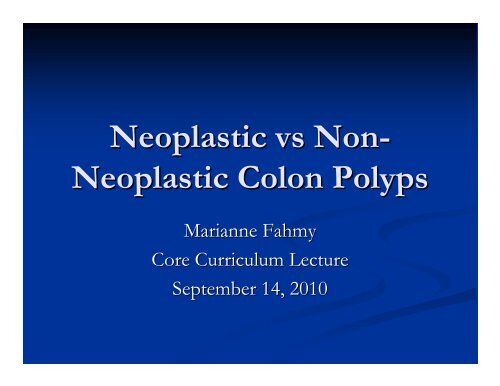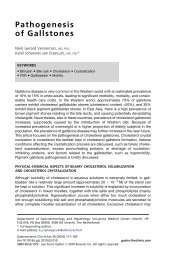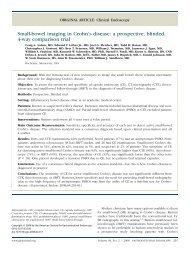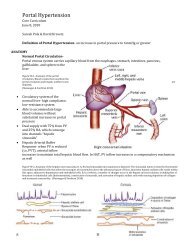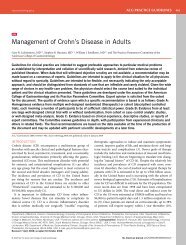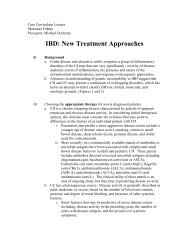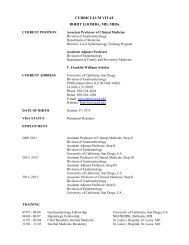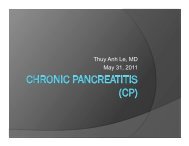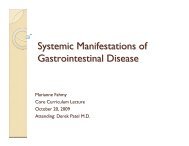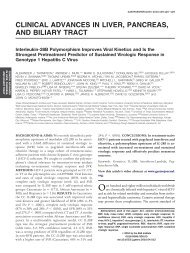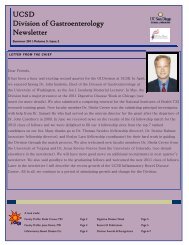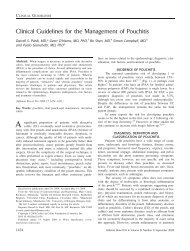Neoplastic vs Non- Neoplastic Colon Polyps
Neoplastic vs Non- Neoplastic Colon Polyps
Neoplastic vs Non- Neoplastic Colon Polyps
Create successful ePaper yourself
Turn your PDF publications into a flip-book with our unique Google optimized e-Paper software.
<strong>Neoplastic</strong> <strong>vs</strong> <strong>Non</strong>- <strong>Non</strong><br />
<strong>Neoplastic</strong> <strong>Colon</strong> <strong>Polyps</strong><br />
Marianne Fahmy<br />
Core Curriculum Lecture<br />
September 14, 2010
�� <strong>Non</strong>-<strong>Neoplastic</strong> <strong>Non</strong> <strong>Polyps</strong><br />
�� Hamartomatous<br />
Outline<br />
<strong>Neoplastic</strong> <strong>Polyps</strong><br />
�� Hyperplastic<br />
�� Mucosal<br />
�� Inflammatory Pseudopolyps<br />
�� Submucosal (can be non-neoplastic non neoplastic and neoplastic)<br />
Hamartomatous<br />
�� Juvenile <strong>Polyps</strong><br />
�� Peutz-Jeghers<br />
Peutz Jeghers<br />
�� Inherited Family Disorders: Polyposis syndromes<br />
�� <strong>Neoplastic</strong> <strong>Polyps</strong> (adenomas and carcinomas)
I. <strong>Non</strong>-<strong>Neoplastic</strong> <strong>Non</strong> <strong>Neoplastic</strong> <strong>Colon</strong> <strong>Polyps</strong>
Hyperplastic <strong>Polyps</strong><br />
�� Most common non-neoplastic non neoplastic polyp in the colon<br />
�� Do not exhibit dysplasia<br />
�� Proliferation is mainly in the basal portion of the crypt<br />
(used to distinguish from adenomas)<br />
�� Typically located in the rectosigmoid and are < 5mm in<br />
size<br />
�� Small left sided HP are not a significant marker of<br />
colon cancer risk and finding them on sigmoidoscopy is<br />
NOT a routine indication for colonoscopy
Inflammatory Pseudopolyps<br />
�� Irregularly shaped islands of residual intact<br />
colonic mucosa that are the result of the<br />
mucosal ulceration and regeneration that occurs<br />
in IBD (benign with no malignant potential).<br />
�� Usually multiple, filiform and scattered<br />
throughout the colitic region of the colon<br />
�� However, their presence can complicate the<br />
recognition of true adenomas and DALM
Submucosal <strong>Polyps</strong><br />
�� Lymphoid aggregates, lipomas, leiomyomas,<br />
pneumatosis cystoid intestinalis, hemangiomas,<br />
fibromas, carcinoids, and metastatic lesions<br />
�� Can be neoplastic or non-neoplastic<br />
non neoplastic<br />
�� Smooth overlying mucosa<br />
�� Lipoma can be diagnosed endoscopically because of its<br />
yellow color and softness (pillow sign)<br />
�� EUS can be useful in defining the site of origin and for<br />
biopsy of submucosal lesions if the diagnosis is in<br />
doubt.
II. Hamartomatous <strong>Polyps</strong>
Hamartomatous <strong>Polyps</strong><br />
�� Result of faulty development, made up of a mixture of<br />
tissues<br />
�� Juvenile polyps:<br />
�� consist of lamina propria and dilated cystic glands rather than<br />
increased numbers of epithelial cells<br />
�� Usually removed because of high likelihood of bleeding.<br />
�� More common in childhood.<br />
�� Peutz-Jeghers Peutz Jeghers <strong>Polyps</strong><br />
�� Glandular epithelium supported by smooth muscle cells that is<br />
contiguous with the muscularis mucosa.<br />
�� Associated with Peutz-Jeghers Peutz Jeghers syndrome<br />
�� <strong>Polyps</strong> are benign- benign but may grow progressively and produce<br />
symptoms or undergo malignant transformation
Inherited Disorders<br />
I: Hamartomatous Polyposis syndrome: Peutz- Peutz<br />
Jeghers Syndrome and Familial Juvenile Polyposis<br />
II: Adenomatous <strong>Polyps</strong>osis Syndrome: Familiar<br />
Adenomatous Polyposis<br />
III: Hyperplastic Polyposis Syndrome
Peutz-Jeghers Peutz Jeghers Syndrome<br />
�� Autosomal dominant hamartomatous polyposis syndrome<br />
associated with mucocutaneous hyperpigmentation<br />
�� For individuals with a histopathologically confirmed hamartoma,<br />
a definite diagnosis of PJS requires two of the following three<br />
findings:<br />
�� Family history consistent with autosomal dominant inheritance<br />
�� Mucocutaneous hyperpigmentation<br />
�� Small-bowel Small bowel polyposis<br />
�� Variable penetrance: variable size and variable number of<br />
hamartomatous polyps<br />
�� <strong>Polyps</strong> begin to grow in first decade of life and become<br />
symptomatic between ages of 10 and 30<br />
�� Presenting symptoms include intussusception, small bowel<br />
obstruction, bleeding, and anemia
PJS - cont<br />
�� Increased risk for both GI and non-GI non GI<br />
malignancies: small intestine, gastric,<br />
pancreatic, colorectal, esophageal, ovarian, lung,<br />
endometrial, and breast<br />
�� Genetic testing: only identifiable mutations<br />
causing PJS affect the tumor suppressor gene<br />
STK 11
Screening in PJS<br />
�� From birth to age 12. In male patients: history and physical examination examination<br />
with<br />
attention to the testicles. Routine blood tests annually (ultrasound (ultrasound<br />
of the<br />
testicles every two years until age 12 offered as an option). For For<br />
female<br />
patients: History and physical examination with routine blood tests tests<br />
annually.<br />
�� At age 8. For males and females: upper endoscopy and small bowel series; if<br />
positive, continue every two to three years.<br />
�� From age 18 on. In male patients: colonoscopy, upper endoscopy, and small<br />
bowel series every two to three years. In female patients: <strong>Colon</strong>oscopy, <strong>Colon</strong>oscopy,<br />
upper<br />
endoscopy, and small bowel series every two to three years; breast breast<br />
self-exam self exam<br />
monthly. Emerging data suggest that wireless capsule endoscopy may may<br />
be an<br />
alternative for small bowel imaging. Similarly, push-enteroscopy<br />
push enteroscopy or double-<br />
balloon enteroscopy may be an alternative for small bowel imaging, imaging,<br />
while also<br />
having the benefit of permitting therapeutic intervention, although although<br />
they are<br />
more invasive.<br />
�� From age 25 on. For male/female patients: endoscopic ultrasound of the<br />
pancreas every one to two years (CT scan and/or CA19-9 CA19 9 offered as options).
Familial Juvenile Polyposis<br />
�� Occurrence of 10 or more juvenile polyps<br />
�� Autosomal dominant pattern of inheritance with germline<br />
mutation in SMAD4 gene chromosome 18q21.1 or in the gene<br />
BMPRA1A.<br />
�� Associated with increased risk for the development of CRC, and<br />
in some families, GASTRIC cancer, especially where there are<br />
both upper and lower gastrointestinal polyps.<br />
�� JPS may co-exist co exist with Osler-Weber<br />
Osler Weber-Rendu Rendu syndrome which<br />
carries a risk of aortic aneurysm and PE<br />
�� Screening: colonoscopy q1-2 q1 2 years beginning at age 15; EGD or<br />
UGI with SBFT q1-2 q1 2 years beginning at age 25
Familial Adenomatous Polyposis<br />
�� Autosomal dominant – linked to the adenomatous<br />
polyposis coli (APC) gene located on chromosome<br />
5q21<br />
�� Large intestine contains multiple adenomatous polyps<br />
(>100)<br />
�� Disease penetrance is nearly 100% by age 40 (mean age<br />
of death 42 if left untreated)<br />
�� Treatment: Total proctocolectomy with a Brooke<br />
ileostomy <strong>vs</strong> subtotal colectomy with ileorectal<br />
anastomosis
FAP (cont)<br />
�� Extracolonic malignances/manifestions: duodenal<br />
ampullary carcinoma, follicular papillary thyroid cancer,<br />
childhood hepatoblastoma, gastric carcinomas, CNS<br />
tumors (medulloblastomas), Congenital hypertrophy of<br />
the retinal pigment epithelium<br />
�� Genetic testing: should be performed on an affected<br />
members. If no mutation found then all at-risk at risk family<br />
members should undergo endoscopic screening (flex sig<br />
or colonoscopy every year starting at age 10 to 12 and<br />
continuing until age 35 or 40 if negative) since<br />
commercial tests for APC mutations do not detect all<br />
mutations that can cause FAP
�� Turcot’s Turcot s syndrome<br />
Variants of FAP<br />
�� Association with brain tumors (medulloblastomas and<br />
gliomas) and FAP or HNPCC<br />
�� Gardner’s Gardner s syndrome: extraintestinal lesions<br />
�� Desmoid tumors, sebaceaous or epidermoid cysts, lipomas,<br />
osteomas, supernumery teeth, gastric polyps, juvenile<br />
nasopharyngeal angiofibromas<br />
�� Attenuated FAP<br />
�� Milder phenotypical FAP variant; < 100 adenomas<br />
�� Fever extracolonic manifestions<br />
�� Delayed onset of colorectal cancer (delayed by 12 years)
Screening in FAP<br />
�� ASGE: Patients with FAP should undergo upper<br />
endoscopy with both end-viewing end viewing and side-viewing side viewing<br />
instruments. The optimal timing of initial upper<br />
endoscopy is unknown, but could be performed around<br />
the time the patient is considered for colectomy, or<br />
early in the third decade of life. If no adenomas are<br />
detected, another exam should be performed in five<br />
years because adenomatous change may occur later in<br />
the course of the disease<br />
�� Biopsies of gastric polyps should be performed to<br />
confirm that they are fundic glands and not adenomas<br />
�� Palpation of thyroid annually (thyroid blastoma)
Hyperplastic Polyposis Syndrome<br />
�� Characterized by multiple, large, proximal hyperplastic polyps<br />
(occasionally small numbers of serrated adenomas)<br />
�� Associated with increased risk of CRC<br />
�� WHO criteria<br />
�� At least 5 HP proximal to the sigmoid colon, of which 2 are greater greater<br />
than<br />
1 cm or<br />
�� Any number of HP occurring proximal to the sigmoid colon in an<br />
individual who has a first degree relative with hyperplastic polyposis polyposis<br />
or<br />
�� Greater than 30 HP distributed throughout the colon<br />
�� If there are many polyps in the proximal colon may consider<br />
colectomy<br />
�� Only remaining polyposis condition for which no germline<br />
mutation has been identified<br />
�� 1-3 3 year surveillance colonoscopies have been proposed
<strong>Neoplastic</strong> <strong>Polyps</strong>
Adenomatous <strong>Polyps</strong><br />
�� 2/3 of colonic polyps are adenomas<br />
�� By definition they are dysplastic and have malignant<br />
potential<br />
�� Time for development of adenomas to cancer is about<br />
7 to 10 years.<br />
�� Advanced adenoma: adenoma:<br />
high grade dysplasia or adenoma that<br />
is > 10 mm in size or with villous component<br />
�� Synchronous adenoma: adenoma:<br />
adenoma that is diagnosed at same<br />
time as index colorectal neoplasm<br />
�� Metachronous adenoma: adenoma:<br />
diagnosed at least six months after<br />
diagnosis of previous adenoma
Epidemiology of Adenoma<br />
�� Older age is a major risk factor<br />
�� More common in men<br />
�� Large adenomas (> 9mm) may be more<br />
common in African Americans<br />
�� African Americans have a higher risk of right-<br />
sided colonic adenomas and may present with<br />
cancer at a younger age (< 50 years) than<br />
Caucasians.
Endoscopic Classification<br />
�� Sessile – base is attached to colon wall<br />
�� Pedunculated – mucosal stalk is interposed<br />
between the polyp and the wall (small polyps <<br />
5 mm are rarely pedunculated)<br />
�� Flat – height less than one-half one half the diameter of<br />
the lesion.<br />
�� Depressed lesions appear to be particularly likely<br />
to harbor high-grade high grade dysplasia or be malignant<br />
even if small.
Pathologic Classification<br />
�� Low grade dysplasia: characterized by branching crypts<br />
lined by cells with long, thin nuclei that begin to stratify,<br />
resulting in increased nucleus-to nucleus to-cytoplasm cytoplasm ratio and a<br />
loss of normal goblet cells.<br />
�� High grade dysplasia: do not contain invasive<br />
malignancy, which is defined by breach of the<br />
muscularis mucosa by neoplastic cells.<br />
�� Represents an intermediate step in the evolution from low-<br />
grade adenomatous polyp to cancer<br />
�� Not associated with metastasis since there are no lymphatic<br />
vessels in the lamina propria..
Pathology cont.<br />
�� Tubular: account for more than 80 percent of colonic<br />
adenomas. Characterized by a complex network of<br />
branching adenomatous glands.<br />
�� Villous: account for 5 to 15 percent of adenomas. They<br />
are characterized by glands that are long and extend<br />
straight down from the surface to the center of the<br />
polyp, creating finger-like finger like projections.<br />
�� TVA: having 26 to 75 percent villous component<br />
account for 5 to 15 percent of adenomas; combination<br />
of above.
Serrated <strong>Polyps</strong><br />
�� Display features of both hyperplastic and adenoma<br />
�� Were classified in past as HP and benign but new<br />
evidence shows that they may behave as adenomas<br />
�� No guidelines for management; it is generally<br />
recommended that surveillance intervals should follow<br />
that of other adenomas<br />
�� Two types<br />
�� Sessile serrated adenoma – precursors to large HP in<br />
proximal colon of patients with hyperplastic polyposis<br />
�� Traditional serrated adenoma – look and behave as<br />
conventional adenomas; often pedunculated found more<br />
often in distal colon
Risk Factors for High grade<br />
dysplasia and cancer<br />
�� Adenomatous polyps > 1 cm in diameter are risk factor<br />
for containing CRC<br />
�� Villous histology – adenomatous polyps with > 25<br />
percent villous histology are a risk factor for developing<br />
CRC<br />
�� High-grade High grade dysplasia – adenomas with high-grade high grade<br />
dysplasia often coexist with areas of invasive cancer in<br />
the polyp.<br />
�� Number of polyps: three or more is a risk factor for<br />
development of metachronous adenomas with<br />
advanced pathologic features.
Molecular Basis of Colorectal Cancer<br />
�� Colorectal cancer is the second leading cause of<br />
death from cancer among adults.<br />
�� benign adenomatous polyp �� advanced<br />
adenoma with high grade dysplasia ��invasive invasive<br />
cancer
Genomic Instability<br />
�� Chromosomal Instability – most common type of<br />
genomic instability in CRC; changes in chromosomal<br />
copy number and structure.<br />
�� Loss of tumor suppressor genes: APC, P53, SMAD4<br />
�� DNA-Repair DNA Repair Defects – Inactivation of genes required<br />
for repair of base-base base base mismatches in DNA<br />
�� Inherited inactivation: HNPCC (lynch syndrome) – germ line<br />
defects in mismatch-repair mismatch repair genes (MLH1 and MSH2); high<br />
risk of second cancers (endometrial, ovarian, small intestine)<br />
�� Acquired inactivation<br />
�� Aberrant DNA Methylation – causes epigenetic<br />
silencing of genes
Mutational Inactivation of Tumor –<br />
Supressor Genes<br />
�� CRC acquire many genetic changes<br />
�� Changes in the Wnt signaling pathway, is<br />
regarded as the initiating event in colorectal<br />
cancer<br />
�� The most common mutation in CRC inactives the<br />
gene that encodes the APC protein<br />
�� In the absence of functional APC – the brake on B-<br />
catenin – Wnt signaling is inappropriately and<br />
constitutively activated.
Growth Factor Pathways<br />
�� Increased levels of COX-2 COX 2 are found in<br />
approximately two thirds of CRC<br />
�� Loss of 15-PGDH 15 PGDH in 80% of colorectal<br />
adenomas and cancers<br />
�� Clinical trials have shown that the inhibition of<br />
Cox-2 Cox 2 by NSAIDS prevents the development of<br />
new adenomas and mediates regression of<br />
established adenomas (Steinbach et al. The effect of celecoxib, a cox-2 cox 2 inhibitor, in FAP N<br />
Engl J Med 2000;342:1946-52)<br />
2000;342:1946 52)
A 60 year old male presents with recurrent pancreatitis and weight weight<br />
loss. He denies<br />
alcohol use and take no medications. On CT, a cystic mass is found found<br />
in the head of<br />
the pancreas as well as a dilated pancreatic duct. A follow up ERCP reveals a<br />
mucus protruding from the ampulla. He undergoes a colonoscopy as as<br />
part of his<br />
work-up, work up, as he also has iron deficiency anemia.<br />
What type of polyps are associated with this presentation<br />
�� A. Serrated Adenomas<br />
�� B. Hamartomatous polyps<br />
�� C. Hyperplastic polyps<br />
�� D. Villous Adenomas<br />
�� E. Glandular hyperplasia
Answer is B<br />
�� The patient shows features typical of intraductal<br />
mucinous neoplasms (IPMN). The final<br />
diagnosis would be strengthened by cytology<br />
and positive mucin stain.<br />
�� One third of patients with IPMN harbor an<br />
inactivated Peutz-Jeghers Peutz Jeghers gene STK 11/LKB1,<br />
which is associated with hamartomatous polyps<br />
and increase in colon cancer risk.
Which of the following statements is true regarding the<br />
pathogenesis of colorectal cancer?<br />
�� A. Colorectal cancers that demonstrate chromosomal<br />
instability tend to be diploid<br />
�� B. Colorectal cancers that demonstrate microsatellite<br />
instability often have p53 mutations<br />
�� C. Colorectal cancers from familial adenomatous<br />
polyposis patients tend to follow the chromosomal<br />
instability pathway<br />
�� D. Colorectal cancers that demonstrate microsatellite<br />
instability often lack mucin within their tumors.<br />
�� E. Colorectal cancers that arise in patients with IBD<br />
follow the chromosomal instability pathway.
Answer is C<br />
�� The chromosomal instability pathway is observed in 80 to 85%<br />
of sporadic colorectal cancers and also familial adenomatous<br />
polyposis cancers. It is mainly characterized by aneuploidy, with with<br />
loss of heterozygosity at key tumor suppressor gene loci,<br />
including APC, chromosome 18q, and p53. Tumors that<br />
demonstrate microsatellite instability have a different genetic<br />
pattern that does not involve p53 and tend to be right-sided right sided<br />
colon location, poorly differentiated, and more likely to be<br />
mucinous. IBD associated colorectal cancers demonstrate a<br />
different timing and pattern of molecular alterations than the<br />
CIN and MSI pathways, with p53 mutations occurring early but<br />
with rare APC and K-RAS K RAS mutations.
A 35 year old male with no significant family history presents with with<br />
iron deficiency anemia. A<br />
colonoscopy was performed as part of his work up and revealed approximately approximately<br />
200 polyps<br />
distributed throughout the entire colon. Histology of the polyp reveals them to be adenomas.<br />
What is the appropriate next step?<br />
�� A. Perform total colectomy with mucosal proctectomy, then<br />
genetic counseling and testing for APC germline mutation.<br />
�� B. Perform surveillance colonoscopies annually, with segmental<br />
resection of cancers.<br />
�� C. Perform total colectomy with mucosal proctectomy, then<br />
genetic counseling and testing for hMLH1 and hMSH2 germline<br />
mutations.<br />
�� D. Perform total colectomy with mucosal proctectomy, then<br />
genetic counseling and testing for SMAD4 and BMPR1A<br />
germline mutations.<br />
�� E. Perform total colectomy with mucosal proctectomy, then<br />
genetic counseling and testing for PTEN germline mutations.
Answer is A.<br />
�� This patient has multiple adenomas, which makes it<br />
most likely that the patient carries a germ line mutation<br />
in APC or has biallelic mutations in the MYH gene.<br />
Thus, this patient has either an attenuated form of FAP<br />
or MYH polyposis. The risk for colorectal cancer<br />
development is nearly 100% and the patient should<br />
undergo a total abdominal colectomy and subsequently<br />
be referred to genetic counseling and appropriate<br />
testing. Additionally, the patient should contact family<br />
members for screening and potentially genetic testing<br />
purposes.
1118 A 50-year-old woman presents for colorectal cancer screening. Her father had<br />
colon cancer at age 45 and her sister at age 55. Her colonoscopy reveals a cecal<br />
adenocarcinoma. Which of the following statements regarding this syndrome is true?<br />
A. It is inherited in an autosomal recessive<br />
fashion.<br />
B. It causes less than 1% of all colorectal<br />
cancers.<br />
C. There is increased frequency of cancer of the<br />
female genital tract.<br />
D. Germline mutations in the hMSH2 or<br />
hMLH1 genes do not occur.<br />
E. There is a predominance of distal tumors.
1118 C (S&F, ch123)<br />
This family meets the Amsterdam criteria for<br />
HNPCC. This syndrome is inherited in an<br />
autosomal dominant<br />
fashion. There is a predominance of proximal<br />
tumors. Germline mutations in the hMSH2 or<br />
hMLH1 gene<br />
are present in 80% of colon cancers. There is an<br />
increased frequency of cancers of the female<br />
genital tract.<br />
This syndrome accounts for approximately 6%<br />
of all the colorectal cancers, whereas FAP<br />
accounts for less<br />
than 1% (see three tables at end of chapter).
1134 A statistician consults you and wants to know precisely which<br />
test can prevent him from dying of colon<br />
cancer. Which of the following has been shown to decrease<br />
mortality from colorectal cancer?<br />
A. Yearly FOBT<br />
B. Double-contrast barium enema<br />
C. Virtual colonoscopy<br />
D. Yearly digital rectal examination
1134 A (S&F, ch123)<br />
FOBT has been shown in large-scale,<br />
randomized, controlled studies to decrease<br />
mortality from colorectal<br />
cancer with yearly and biannual testing. A<br />
decrease in colorectal cancer mortality has been<br />
demonstrated<br />
with sigmoidoscopy. The National Polyp Study<br />
suggests that removal of adenomatous polyps<br />
reduces the<br />
mortality from colorectal cancer. Thus, it has<br />
been inferred that colonoscopy should have the<br />
same effect.


